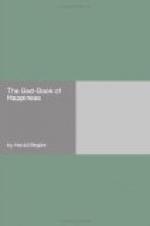[Sidenote: Edward FitzGerald]
I wish you would write me ten lines to say how you are. You are, I suppose, at Cambridge, and I am buried (with all my fine parts, what a shame!) here; so that I hear of nobody—except that Spedding and I abuse each other about Shakespeare occasionally, a subject on which you must know that he has lost his conscience, if he ever had any. For what did Dr. Allen ... say when he felt Spedding’s head? Why, that all his bumps were so tempered that there was no merit in his sobriety—then what would have been the use of a Conscience to him? Q.E.D.
Since I saw you, I have entered into a decidedly agricultural course of conduct: read books about composts, etc. I walk about in the fields also where the people are at work, and the more dirt accumulates on my shoes, the more I think I know. Is not this all funny? Gibbon might elegantly compare my retirement from the cares and splendours of the world to that of Diocletian. Have you read Thackeray’s little book—“The Second Funeral of Napoleon”? If not, pray do; and buy it, and ask others to buy it, as each copy sold puts 7-1/2d. in T.’s pocket, which is very empty just now, I take it. I think this book is the best thing he has done. What an account there is of the Emperor Nicholas in Kemble’s last Review! The last sentence of it (which can be by no other man in Europe but Jack himself) has been meat and drink to me for a fortnight. The electric eel at the Adelaide Gallery is nothing to it. Then Edgeworth fires away about the Odes of Pindar, and Donne is very aesthetic about Mr. Hallam’s book. What is the meaning of “exegetical”? Till I know that, how can I understand the Review?
Pray remember me kindly to Blakesley, Heath, and such other potentates as I knew in the days before they “assumed the purple.” I am reading Gibbon, and see nothing but this d——d colour before my eyes. It changes occasionally to bright yellow, which is (is it?) the Imperial colour in China, and also the antithesis to purple (vide Coleridge and Eastlake’s “Goethe")—even as the Eastern and Western Dynasties are antithetical, and yet, by the law of extremes, potentially the same (vide Coleridge, etc.). Is this aesthetic? Is this exegetical? How glad I shall be if you can assure me that it is! But, nonsense apart and begged pardon for, pray write me a line to say how you are, directing to this pretty place. “The soil is in general a moist and retentive clay, with a subsoil or pan of an adhesive silicious brick formation; adapted to the growth of wheat, beans, and clover—requiring, however, a summer fallow (as is generally stipulated in the lease) every fourth year, etc.” This is not an unpleasing style on agricultural subjects—nor an uncommon one....
* * * * *




